@Northern Forest is a vision to plant millions of trees in a band from Liverpool to Hull.and was one of the few announcements of practical action in the Govts 25 year Defra plan. This plan also mentioned Beauty for the first time in a government document. This is important in explaining the variety of nature not just in its physical beauty – but its beauty of purpose in projects, because wildflowers vary and shape and form, and it is about putting the beauty of that mix too.
So The Northern Flowerhouse – and Northern Forest for the precise vision please can be a great partnership, not least because of the exciting work was already undertaken in pilot work nationally between the Landlife and the Woodland Trust, which have proved there are more than one way to plant trees, and flowers can be a big part of that.
1 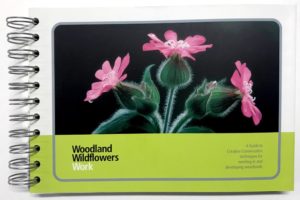 2
2 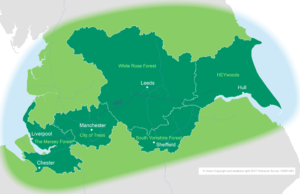
Picture 1: Previous publication by Landlife on how wildflowers work in woodland management
Picture 2: Map for a Northern Forest(picture from the Mersey Forest)
Austin Brady came to the launch and celebration of the National Wildflower Centre on May 31st to explain this connection. (Video clip of Austin Brady at NWC launch). It also should of an exciting Dragon connection which reflect back on exciting artwork, exhibited across the North and internationally.
It also shows exciting connections to pioneering art projects by visionary environmental artists Helen and Newton Harrisons whose insight for ecology carried across the same planting zone of river catchments and National Parks, and heralded new themes for discussion that ripple across these projects in term of sound ecological principles and natural capital.
From September 1996 to September 1998 I was Project Manager and lead researcher for a project with the pre-eminent ecological artists, Helen Mayer Harrison and Newton Harrison, on their project for Artranspennine98. They were invited by the Henry Moore Foundation, Leeds, and Tate Liverpool to create a work that would connect the two cities, but The Harrisons imagined an entire ecological domain.
By Richard Scott
Casting A Green Net: Can It Be We Are Seeing A Dragon?
The Fine Arts Department at Manchester Metropolitan University hosted The Harrisons’ ‘Open Studio’ where the five 2 x 3.5 meter maps were drawn as a learning exercise for students and many people from across all disciplines contributed their stories of the region. During this time, I had a research placement at the Institute for Terrestrial Ecology and I drove The Harrisons many times back and forth to see the landscape on the ground, while taking time to visit farmers and talk to many people from different sectors. The stories of the people we met contributed to the poetic texts that accompanied the different ecological aspects represented by each map.
The shape of the Dragon was established initially by Helen, who imagined a giant standing at Liverpool, casting a magical net that connected all green places, ecologically. West to East, this ‘rhymed the Mersey and Humber estuaries’. North and South edges were established by using the Roman roads we had travelled, that were the early Pennine salt route crossings. As the National Parks were added, Newton declared that they looked like the wings of a Dragon.
The five maps, or ‘ecological icons’ were:
- Casting a Green Net – portrays the ecological principles and explorations of the region to determine its boundaries and its water flows.
- Sunlight on the Dragon – depicting the potential richness of biodiversity across the region.
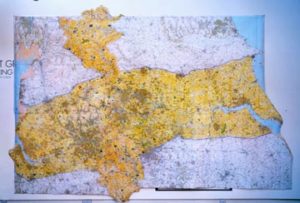
- The Great Green Farm – imagined the region as a food generator that recycled organic waste as a metabolism.
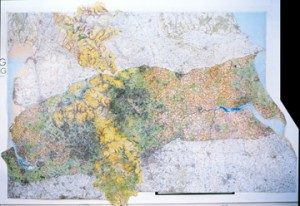
- The Urban Edge/Disaster Strip – considered the effects of unfettered market forces on urban sprawl development.
- The Eco-Urban Edge – proposed an economic engine to fulfil new housing needs, define, value and contain urban culture to connect forests ecologically.
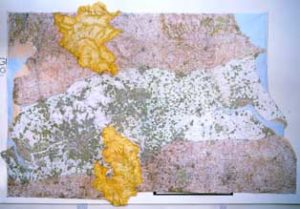
- Dragon Flies the Trade Route – was a sixth story that placed the region in its European spatial planning context. As Trade Route E20 it stretches from Limerick across Northern England and other EU countries to St Petersburg, to prevent former Soviet Union countries from trading with Russia.
Through the Summer of 1998, the work was exhibited at Liverpool’s Bluecoat Gallery for three months and then for a seminar at Dean Clough in Halifax. It was finally shown in England in 2000, at the Adelphi Hotel in Liverpool for the Society for Ecological Restoration’s first World Conference, where the Harrisons gave a keynote presentation. Thereafter it was exhibited at the Aachen Museum of International Art, Germany and at Ronald Feldman Fine Arts in New York.
It is encouraging to see the potential for the new Northern Flowerhouse to redraw the domain of the Green Dragon for real; joining with the Woodland Trust’s Northern Forest to provide an ecologically provident Northern Powerhouse… “a region that values ecology as well as economics” … a region that may heal from industry and extraction to reconnect and support all forms of life for diverse futures.
http://theharrisonstudio.net/casting-a-green-net-can-it-be-we-are-seeing-a-dragon

